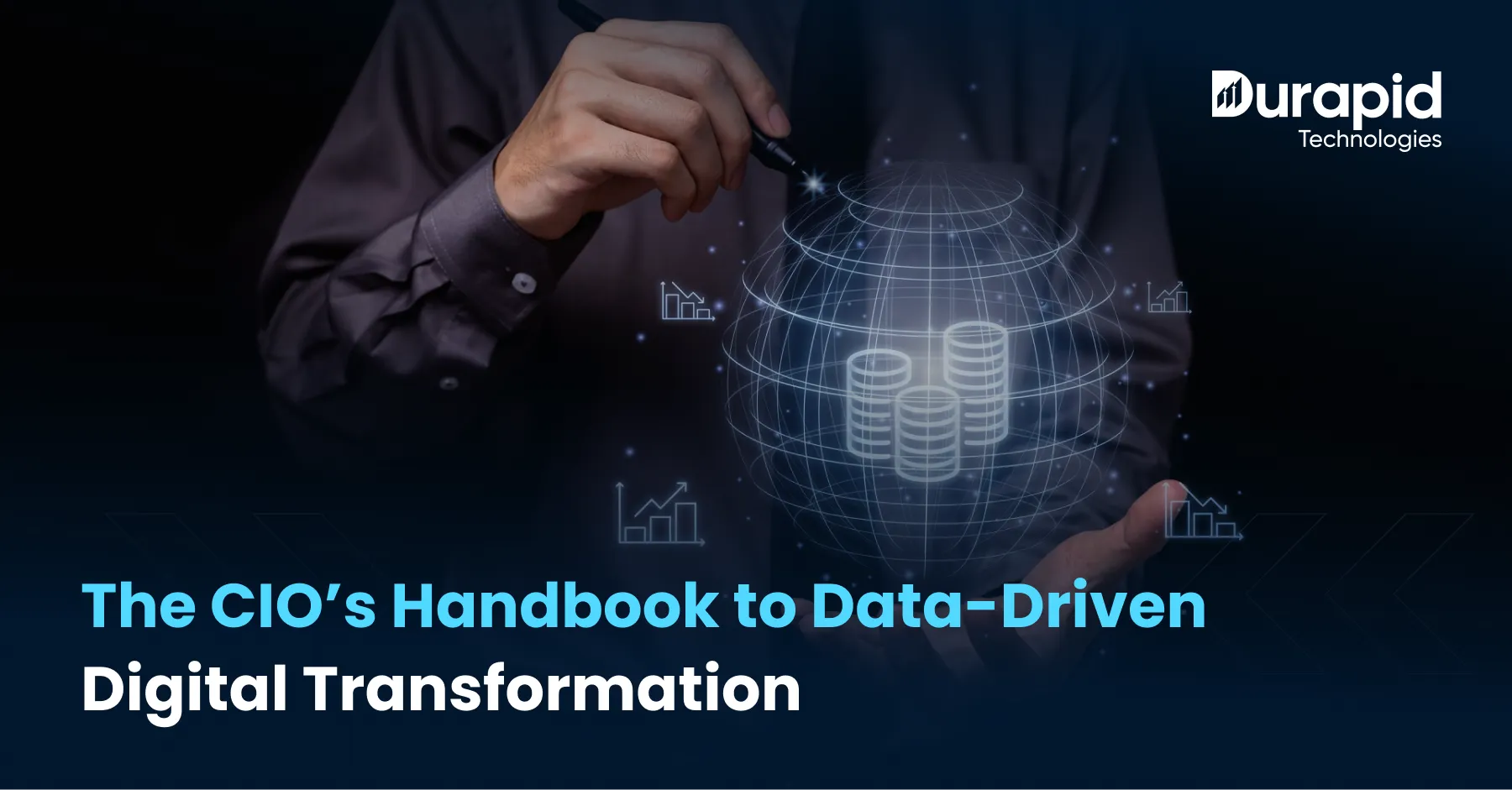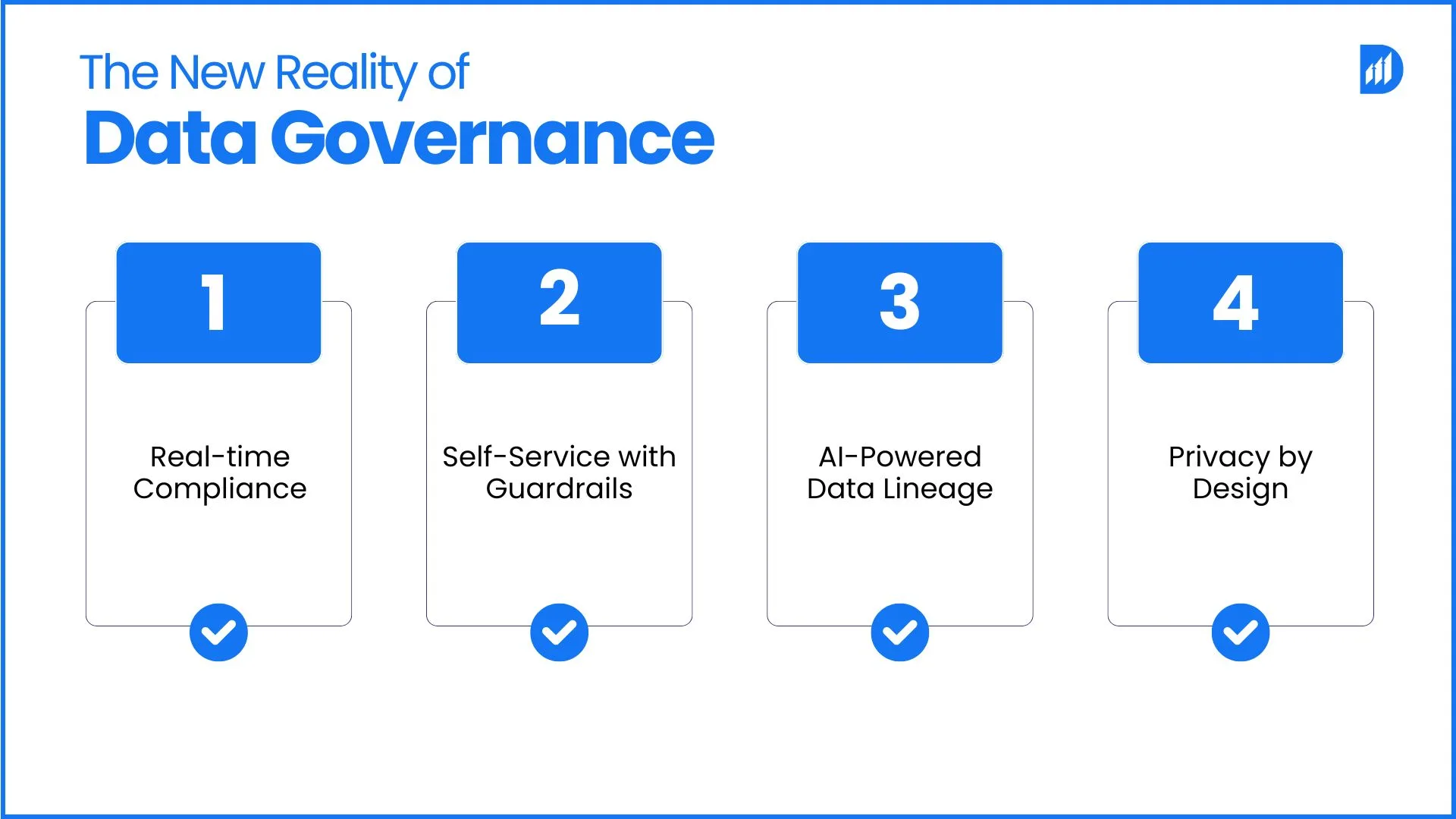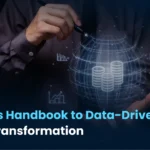The CIO’s Handbook to Data-Driven Digital Transformation

Your board wants digital transformation. Yesterday. Your CEO is asking why competitors are moving faster. Your CFO wants to see ROI from all that cloud spending. And your teams are drowning in data that somehow never turns into actionable insights.
Sound familiar?
Here’s what we’ve learned after helping 35+ organizations navigate digital transformation at Durapid Technologies: most companies are approaching this backwards. They’re buying tools before building strategy. Installing platforms before understanding their data. Chasing the latest tech trends instead of solving actual business problems.
But the companies getting it right? They start with data strategy. Everything else flows from there.
Why Data Strategy is the Core of Digital Transformation
Let’s cut through the noise. Digital transformation isn’t about adopting new technology—it’s about using data to make better decisions faster.
Think about the most successful digital transformations you’ve seen. Amazon didn’t just build an e-commerce platform; they created a data engine that predicts what you want before you know it. Netflix didn’t just stream videos; they built recommendation algorithms that keep you watching. Tesla didn’t just make electric cars; they collect data from every vehicle to improve autonomous driving.
The pattern is clear: data strategy drives everything else.
Your Current Reality Check
Most enterprise data looks like this:
→ Sales data lives in CRM
→ Financial data sits in ERP
→ Customer data spreads across multiple touchpoints
→ Operations data stays trapped in legacy systems
→ Analytics teams spend 80% of their time just finding and cleaning data
This isn’t digital transformation. This is digital chaos.
At Durapid, our 15+ certified cloud consultants see this pattern constantly. Organizations invest millions in new platforms but can’t answer basic questions like “Which customers are most profitable?” or “What’s our actual cost per acquisition?”
The solution isn’t more tools. It’s a unified data strategy.
The Foundation That Actually Works
Real digital transformation starts with three pillars:
Data Integration: Breaking down silos so information flows seamlessly across systems. Our Microsoft-certified professionals have integrated everything from SAP to custom applications using Azure Data Factory and Synapse Analytics.
Data Quality: Ensuring your decisions are based on accurate, complete, consistent information. We’ve seen too many AI projects fail because the underlying data was garbage.
Data Accessibility: Making insights available to the right people at the right time through intuitive interfaces and automated reporting.
When these three elements align, transformation accelerates exponentially.
Data Governance in 2025
Data governance used to be the boring compliance topic that made everyone’s eyes glaze over. Not anymore.
With AI becoming central to business operations, data governance has become your competitive advantage. Companies with strong governance move faster, take smarter risks, and build more reliable AI systems.
The New Reality of Data Governance
2025 governance looks completely different from traditional approaches:

Real-time Compliance: Instead of quarterly audits, governance systems monitor data quality, usage, and compliance continuously. Our Azure-based solutions include automated alerts when data patterns suggest potential issues.
Self-Service with Guardrails: Business users can access and analyze data directly, but within predefined security and quality parameters. This speeds up decision-making while maintaining control.
AI-Powered Data Lineage: Understanding where data comes from and how it’s transformed is crucial for AI reliability. Our Databricks implementations include full lineage tracking so you always know why your models make specific predictions.
Privacy by Design: With regulations evolving globally, privacy isn’t an afterthought—it’s built into every data pipeline and analytics process.
Governance That Enables, Not Restricts
The best governance frameworks feel invisible to end users. They work in the background, ensuring data quality and security while enabling self-service analytics and rapid experimentation.
We’ve implemented governance solutions for financial services clients handling sensitive credit data and healthcare organizations managing patient information. The common thread? Governance that accelerates innovation instead of slowing it down.
Our approach includes automated data classification, role-based access controls, and continuous monitoring that adapts to changing business needs. Teams get the data they need without compromising security or compliance.
Composable Platforms & RAG-native Data
The technology landscape is shifting toward composable architectures, and data platforms are leading this change.
What Does Composable Actually Mean?
Instead of monolithic platforms that try to do everything, composable data architectures use specialized components that work together seamlessly. Think of it like building with Lego blocks—each piece has a specific function, but they connect to create complex solutions.
Our 20+ Databricks-certified professionals build these composable solutions daily:
Data Ingestion Layer: Handles streaming and batch data from multiple sources using Azure Event Hubs and Kafka
Storage Layer: Optimized for different data types using Azure Data Lake and Cosmos DB
Processing Layer: Transforms and enriches data using Spark and custom algorithms
Analytics Layer: Provides insights through Power BI, custom dashboards, and API endpoints
AI/ML Layer: Enables intelligent applications using Azure ML and OpenAI services
The RAG-native Revolution
RAG (Retrieval-Augmented Generation) is changing how organizations interact with their data. Instead of predefined reports and dashboards, users can ask natural language questions and get intelligent responses based on their actual business data.
We’ve built RAG-native platforms for clients across industries:
Financial Services: “Show me all high-risk accounts in the Mumbai region with declining payment patterns over the last quarter”
Healthcare: “What treatment protocols show the best outcomes for patients with similar profiles?”
Manufacturing: “Which production lines are most likely to need maintenance in the next 30 days?”
The power isn’t just in getting answers, it’s in asking better questions. When business users can explore data conversationally, they discover insights that traditional reporting would never surface.
Implementation Reality
Building composable, RAG-native platforms requires careful architecture planning. Our teams work with organizations to:
→ Assess current data architecture and identify integration points
→ Design modular components that can evolve independently
→ Implement robust APIs for seamless component communication
→ Build security and governance into every layer
→ Train teams on new ways of working with data
The result is a platform that adapts to changing business needs without requiring complete rebuilds.
Success Stories from Industry
Theory is one thing. Results are another. Here are real transformations we’ve enabled:
Financial Services: Credit Risk Revolution
A major bank approached us with a challenge: their credit risk assessment process took days and relied on outdated models. Loan officers couldn’t get real-time risk scores, leading to either conservative lending or unexpected defaults.
Our solution combined multiple data sources, credit bureaus, transaction history, market indicators, and alternative data into a unified platform using Azure Synapse and Databricks.
The results:
→ Credit decisions reduced from days to hours
→ Default rates decreased by 15% through better risk modeling
→ Loan approval rates increased by 20% for qualified applicants
→ Regulatory compliance improved with automated documentation
The platform now processes thousands of applications daily while continuously learning and improving its predictions.
Healthcare: Patient Outcomes Optimization
A healthcare network was struggling with fragmented patient data across multiple systems. Doctors couldn’t get complete patient pictures, leading to redundant tests and suboptimal treatment decisions.
We built a unified patient data platform integrating EMRs, lab systems, imaging, and external health data using HL7/FHIR standards and Azure Cognitive Services for medical transcription.
The impact:
→ 30% reduction in duplicate tests and procedures
→ 25% improvement in treatment outcome metrics
→ Real-time clinical decision support for providers
→ Predictive models for patient risk stratification
Most importantly, doctors now spend more time with patients instead of hunting for information across multiple systems.
Manufacturing: Predictive Maintenance Success
A manufacturing client was losing millions annually to unplanned equipment downtime. Their maintenance approach was reactive, leading to production disruptions and emergency repairs.
Our IoT and AI solution collects data from sensors across the production floor, analyzes patterns, and predicts equipment failures before they happen.
The transformation:
→ 40% reduction in unplanned downtime
→ 60% decrease in emergency maintenance costs
→ 25% improvement in overall equipment effectiveness
→ Optimized maintenance schedules based on actual usage patterns
The platform now monitors thousands of assets and has prevented dozens of potential production shutdowns.
Measuring Transformation ROI
Digital transformation ROI goes beyond cost savings. The most successful organizations track multiple metrics:
Operational Efficiency
- Process automation rates
- Decision-making speed
- Error reduction percentages
- Resource optimization metrics
Business Growth
- Revenue from new digital products/services
- Market expansion enabled by data insights
- Customer acquisition and retention improvements
- Competitive advantage metrics
Innovation Capability
- Time-to-market for new initiatives
- Experimentation velocity
- AI/ML model deployment frequency
- Data-driven decision percentage
Our clients typically see positive ROI within 12-18 months, but the real value comes from sustained competitive advantages that compound over time.
The Path Forward
Digital transformation isn’t a destination, it’s an ongoing journey of using data to create business value.
The organizations succeeding in 2025 share common characteristics:
→ They treat data as a strategic asset, not a byproduct
→ They invest in platforms that adapt and evolve
→ They build governance that enables innovation
→ They measure success through business outcomes, not technical metrics
At Durapid Technologies, our 300+ skilled developers and 150+ Microsoft-certified professionals have guided organizations through every stage of this journey. From initial data strategy to fully autonomous AI systems, we’ve seen what works and what doesn’t.
The future belongs to organizations that can turn data into decisions, insights into actions, and information into competitive advantage.
Your digital transformation journey starts with a single question: What decisions could you make better if you had the right data at the right time?
The answer to that question becomes your roadmap.
Frequently Asked Questions
What is a RAG-native platform?
RAG-native platforms combine retrieval systems with generative AI to answer questions using your actual business data. Instead of static reports, users can ask natural language questions like “Which products had the highest margin last quarter?” and get intelligent responses based on real-time data. The platform retrieves relevant information and generates contextual answers, making data exploration conversational and intuitive.
How does data governance help digital transformation?
Data governance provides the foundation for reliable digital transformation by ensuring data quality, security, and accessibility. It enables self-service analytics while maintaining compliance, speeds up AI development through trusted data sources, and reduces project risks by establishing clear data standards. Good governance accelerates transformation by making data assets reusable and reliable across the organization.
How can data analytics drive business growth?
Data analytics drives growth through better decision-making, customer insights, and operational optimization. It enables personalized customer experiences, identifies new market opportunities, optimizes pricing and inventory, and predicts future trends. Analytics also improves operational efficiency by identifying bottlenecks, automating processes, and enabling predictive maintenance. The key is turning insights into actionable business strategies.
Ready to accelerate your data-driven digital transformation? Durapid Technologies has helped 35+ organizations build composable, RAG-native data platforms. Contact us at sales@durapid.com or visit www.durapid.com to discuss your transformation strategy.





